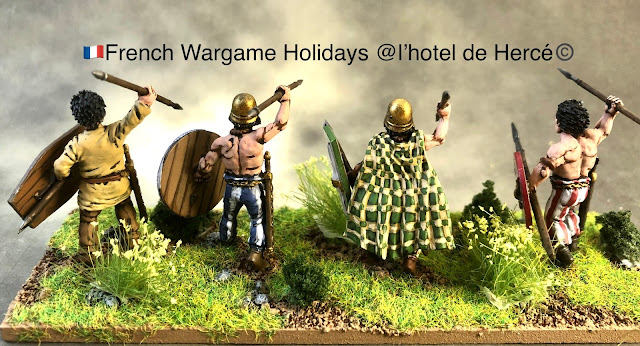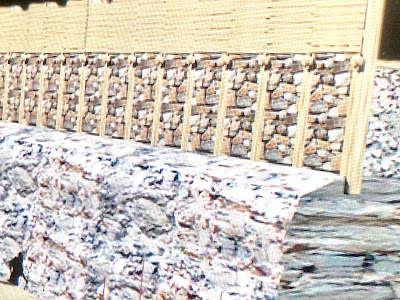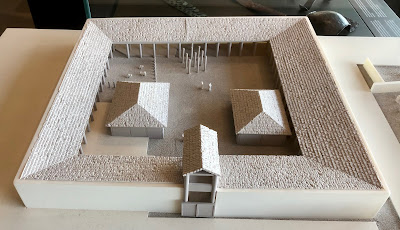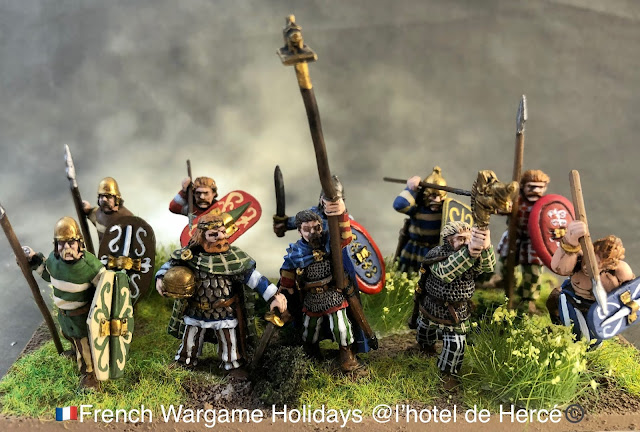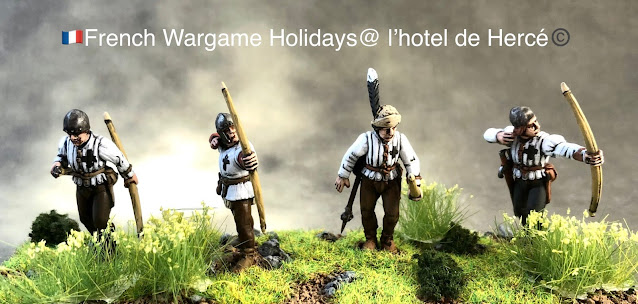Saturday, November 14, 2020
Aulerci Cénomani I
Thursday, November 12, 2020
English Longbowmen Guerre Folle -The Mad War II
English Longbowmen
Completed one of my English Mercenary longbowmen bases to add to the Breton army. 28mm Miniatures are from the Perry Miniatures Range.
Edward Woodville, known as Lord Scales, fought in the war of the roses supporting Edward IV, after Edwards death he fled when the Duke of Gloucester seized power and declared himself Richard IIIrd, his brother Anthony was executed being an ally and uncle of the two princes who later die in the tower.
Edward Woodville flees to Brittany and along with the future King Henry VIII, he later returns to England and fights at Bosworth, leading the valiant vanguard. After Henry VIII became king he inherited his brothers estates which was confirmed in 1485 including the captaincy of the Isle of Wight and his castles at Portchester and Carisbrooke.
Edward uncle of the Queen Elizabeth, approached Henry VIIth to raise an army to support the Bretons who had a long alliance with England, However Henry had been also supported by the French and the Bretons for his return to England, so he was undecided upon what action to take.
On April 23rd 1488 two ambassadors of Francis II of Brittany arrived in England to plead with Henry VII, also partaking in the investiture of Sir Edward into the order of the garter due to his prowess at the battle of Bosworth. Henry VII is unconvinced by the Ambassadors and he explicitly orders on the pain of death that no one from England was to get involved in the war in Brittany.
Edward departs for the Isle of wight with the two Breton Ambassadors and offers his services as a mercenary Captain as he had done previously for the Bretons in 1472 and the Spanish in 1475. The exact size of the company is unknown, some contemporary Breton accounts say 300 others as large as 800. I am leaning toward a mid range numbers due to the claim in the Breton financial accounts of 660 men. It is thought 400 archers, 40 knights and squires depart the Isle of Wight. Armed with pikes bows and arrows and dressed in white tunics with a red cross.
On May 20th 1488 Edward departed the Isle of wight with his company and arrived in Saint Malo a few days later(although accounts have him landing at Honfleur also, but that could be more english mercenaries ?). Edward and his company fight a small skirmish at Dinan against the comte de D'Aunay, losing 20 odd men (French accounts inflate this to 240). A further 200 odd english mercenaries arrive from Portsmouth on a Breton salt ship and a French ship captured in Portsmouth harbour along with an Ambassador of the Scots and his son, all of the 200 english men were veterans and had previously fought with Edward in Spain in 1487.
Edward arrives in Rennes on the 5 of June, they are welcomed by a reception committee, in their honour two red Bordeaux wine barrels are opened in rue Haute, and two barrels of white in place Bout du Cohue (next to medieval grand hall). A group of musicians and play and a young boy is doing tumbling tricks. A banquet is held for the officers in the ducal palace, a menu still exists and it consisted of one and a half vealers, two and a half sheep, three kids (goats), two hares, twenty eight rabbits, eight goslings, thirty six chickens, twenty-eight pigeons, one barrel of Bordeaux wine, one barrel of white wine, and seven estamaux (cauldrons) of hypocras (mulled spicy wine). The company and was the only available force in arms to protect the Breton Capital as a ceasefire was in effect and the remainder of the Breton Army was in Nantes and the Rennes muster had returned to their homes for the summer harvest.
On May 27th Henry VII letter of apology arrives in Paris informing Charles VIII of the rouge Edward Woodville, and that he had also seized other ships and men who were to join him. (One knight and more men at arms were seized in Portsmouth)
The French were in a strong position and capture of the key Breton marcher fortresses of Ancenis, Chateaubriant, La Guerche and Redon in May of 1487 and Vitré, Saint-Aubin-du-Cormier and Dol-de-Bretagne in September left Brittany split into north and South and the French on and in the interior lines of the Breton Duchy.
On June 12th Francois calls the muster, but many men do not return to arms as the harvest is not complete, finally a army musters in early July and marches north to Rennes.
On the 6th of July the ceasefire ended and the French immediately advanced from Mayenne and sieged the largest castle in France on the border marches, arriving at the key northern Breton fortress of Fougeres on the 12th of July.
The Breton Army departed Nantes on the 9th moving North and arrived in Rennes on the 25th of July. A council is called in Rennes on the 25th of July between the leaders of the Breton army and the mercenary contingents. On the 27th the Bretons then march to Andouillé-Neuville to gather the muster and join with the men coming from south western Brittany via Dinan, they are then inspected by Francois II and and Princess Anne. The army now numbering 7000 bretons 4500 mercenaries marches towards Saint Aubin du Cormier on the 28th of July. The Bretons felt they needed a phycological edge over the French and clothed two Breton mixed archer divisions with white tunics with the red cross badge of the English some 1700 men in total, giving the French impression that a large contingent of English were now with the army.
Fougeres, the greatest castle of Brittany had fallen after a six day siege on the 17th of July, the great French artillery train had breached the walls in three places and the garrison had surrendered with full honours so the city was saved from a pillage.
The French army departed Fougeres on the route towards Rennes, the Breton capital, clashing with the Bretons on route in a field south of Ville Saint-Aubin-du-Cormier.
I will complete an article about the forces and the battle next week.
cheers
Matt
Wednesday, November 11, 2020
Sarmation Cataphracts
Sarmation Cataphractarii
One of my goals during lockdown is to complete my project drawers are part started figures in between painting my main projects, this last few weeks I have really put a dent in it emptying a drawer almost completely in preparation for my workspace rebuild and also start preparing to refill for next years upcoming projects.I do plan to add at some stage some more Sarmations and build some German tribes to fight my middle imperial Romans, but for now these figures will join my Imperial Roman army.
The figures are from the warlord range, a bit of a pain as they are two part figures, but after pinning and adding green stuff I am quite happy with the results.
cheers
Sunday, November 8, 2020
Gaulois Aulerci Diablintes XIV
200 Aulerci Diablintes painted

Tuesday, November 3, 2020
Gergovie Oppidum Caesars defeat 52BC
Gergovie Gallic Oppidum
On our holidays this year we had the opportunity to visit the site of Gergovie the 46 hectare Gallic Oppidum and capital of the Averni tribe. It is a very impressive site, set in the mountains of the Masif Central overlooking the Puys valley. The museum is excellent and has quite a good collection of artifacts and models of the city based on some archeological evidence of the battle. The site is huge and uneven so bring good walking shoes. Thought to be the first defeat of Caesar by the Gauls, in Caesars accounts 46 centurions died in the battle on the assault of the hilltop fortification of Gergovie.Map of the site of Gergovie with the gates maked with arrows, the southern gate has the square on the left for the entry, a lane still exists today so you can walk it back to the base of the mountain, a warning it is quite treacherous....
Caesars main fortified encampment occupied this hill controlling the entry to Gergovie, it was also the supply route for the city controlling the water supply, to the left was the river. Originally occupied by Gauls it was seized in a night raid by two legions. after seizing the hill a Roman fortification was built. To the right they built a wall some 6klm long with forts along it and 2 legions were stationed at both ends
This is the centre of the view, the Roman wall was built across the valley to the centre to join with the gallic settlement in the middle which became the main Roman encampment then to the right hill on which a third fortification was built. This is also the spur that the Roman and allied troops advanced up (photo from the lower Gallic stone and wooden wall) as you can see it is quite steep.
Looking from the south gate to the right you will see one of the hills captured then fortified by the Romans during the siege at the extreme end of the flank, this is the location that the 10th Legion advanced from to halt the fleeing Roman legions and the departure of the cavalry feint to the left of the Roman lines up the Rizolles ridgeline.
The Roman assault on the fortifications was carried out by four legions and all of the allied Gallic auxillia including the mounted allied Haedui (Aedui) cavalry (who had dubious loyalty after recently rebelling and were on the Roman right flank) meanwhile on the Roman left, a feint was made with more Gallic cavalry, mule riders dressed as roman cavalry and a legion of infantry toward the Rizolles ridge and the northern gate of the Oppidum. The Roman feint was meant to draw off Vercingetorix's cavalry who were on the Rizolles ridgeline defending the only supply route left open to the city.
When the romans assaulted the fortifications they broke through the outer wall of stone and wood with ease, pillaging the gallic campsites and forcing the defenders back to the main walls. During the fighting Lucius Fabius centurion of the legio VIII is said to of mounted the walls near the South gate before being slain (by a women French legend has it). Marcus Petronius Centurion of the VIII sacrificed himself in front of the South gate to save other members of his maniple when they were surrounded. Gallic reserves arrived in time to save the gate from being taken.
It is then thought that Vercingetorix lead the gallic cavalry from the western gate against the roman left flank of Caesars assaulting legions. Vercingetorix riding between the outer and inner wall pinning the romans against the walls. At this point the Roman Allied cavalry of the Haedui (Aedui) arrived on the Roman right flank, the Roman legionaries mistaking them as more Gallic cavalry broke and fled back down the mountain
Caesar he may of lost the entire four legions had not the reserve centuries of XIII lead by Titus Sextius the commander of the siege line walls in the centre and the 10th Legion lead by Caesar arriving on the left flank stopped the pursuing Gallic cavalry as the romans routed back down the mountain towards their own lines.
In Caesars accounts he only lost 700 men and 46 centurions (1/3 of the centurions in the army), but modern scholars think including allies as many as 6000 perished. After the defeat he withdrew his army and Vercingetorix followed him north trying to prevent his link up with Labineius legions fighting south east of Paris against the Parisi, Carnutes and the Aulerci tribe confederation.
Caesar's army consisted of 6 legions during the siege
- Legio V (recruited in Cisalpine Gaul, possibly commanded by Quintus Tullius Cicero)
- Legio VI (recruited in Cisalpine Gaul, possibly commanded by Mark Anthony)
- Legio VIII (highest casualties at the battle)
- Legio X commanded by Caesar personally
- Legio XI
- Legio XIII (commanded Quaestor Lucius Roscius)
- Gallic Auxiliary Infantry, Slingers and javelins
- Cretan archers
- Numidian cavalry ?
- Balearic slingers
- Germanic Auxillia and cavalry
- Gallic cavalry (Aedui) plus other allied tribal cavalry
Gergovie Oppidum Walls
 |
Onager balls, these are the earliest example of caesarean period ones. |
Art and weapons
 |
| Deer representations |


 |
| Gaulois drinking bowl |
Buildings and structures
 |
| Layout of the village |
Gallic Auxillia
Gallic Auxillia
Matt
Saturday, October 31, 2020
Breton compaignie d'ordonannce archers Guerre Folle, the Mad War 1
The Breton Mad War -Mad War
The "Mad War" was the struggle of major feudal lords against centralized royal power. As part of these power struggles, in 1484-1485, Louis II of Orléans tried to seize the crown supported by Francis II of Brittany and a certain number of border lords of Anjou-Maine and Normandy, attempting to depose the regent, Anne de Beaujeu . On 2 November 1485, the Peace of Bourges suspended the hostilities for eight months. The second phase began June 1486 to November 1488, is sometimes called the War of Brittany (Brittany).
The first army I will build will be the Bretons, along with the Gascon, Béarnaise, Aragonese, English, Castilian and German Mercenaries, followed closely by the French, Swiss mercenaries along with Germans and Italians. The armies will focus on the field battle of Saint-Aubin-du-Cormier in 1488. I predominantly will be using the Perry range of WOTR plus the mercenaries pack along with some other bits and pieces from other manufacturers
My first unit off the table is done is Breton archer Skirmishers based for Impetus, the figures are Perry Plastics.
cheers
Matt
